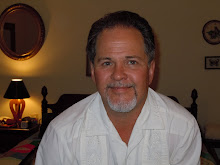Friday, March 23, 2007
The Fender Rhodes Mark ll
My first “live-playing rig” in bands was the 73 key Rhodes Mark ll Stage Piano with a pair of Leslie 60 tone cabinets. This particular Rhodes was a Cadillac so-to-speak, because Rhodes had improved the action and gave it a flat top. Now you could put another synth on top of the Rhodes without worrying it would come sliding off during a gig. The action on the earlier Rhodes was like playing a mattress. The Mark ll was a pleasure to play, and I used it a lot. The sound of the Rhodes is not heard that much in today’s music, because “pop” has taken over the airwaves. Meaty keyboard sounds were the mainstay of the l980’s, but virtual synth technology must have pushed these quality instruments right out the door. I put a Rhodie pre-amp in my Rhodes that gave it active treble and bass boost. You also now had to plug it in or else use a 9 volt battery. If you left a ¼” patch cord plugged into the input jack, it would run the battery down. You needed a big Phillips head screwdriver to get the four screws out that held the harp down. This is not something you want to do on a gig, so I just put a little plug on the dash and used a Radio Shack AC adapter. The Stage version of the Rhodes had no amplifier of its own, so you needed a specialty amp of some sort. The Suitcase version had its own stereo amps built it with a control for tremolo speed. The Leslie 60’s, although rare, were the perfect augmentation of the Rhodes piano sound. They were two wooden speaker cabinets each with a ten inch heavy duty cone speaker. The beauty of the 60’s was they emulated stereo tremolo by using a rotary capacitor that actually was turned by an electric motor. There is a belt and pulley system that was controlled by a pre-amp you mounted on the music rack of the Rhodes. There was a control for volume and one for the speed of the tremolo. I can’t say for sure what the effect was. Some would say chorusing, some maybe an auto-panning or phase shift, but in any case it sounded lush and sweet. Just holding down a chord on the Rhodes would move you. The first synthesizer I owned was a Sequential Prophet 600. It was a scaled down and cheaper version of the popular Prophet 5. It had the unique ability to store patches dialed in on the analog controls. This was a huge breakthrough back in the day. A microprocessor accomplished this with a little touch pad with numbers. The filters and analog oscillators on the Prophet were its claim to fame, and it lush sound was the perfect compliment to the Rhodes piano. I used this combination for many years before moving to an upstairs apartment. As soon as you begin moving that Rhodes up and down those steps, its incredible weight becomes a problem. Luckily to this day I still have my original set up, and it still operates when I chose to use it.
